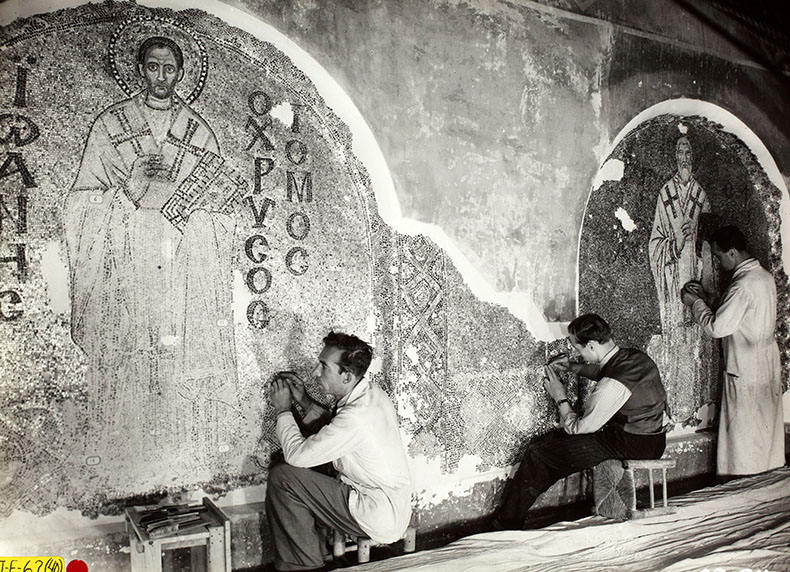
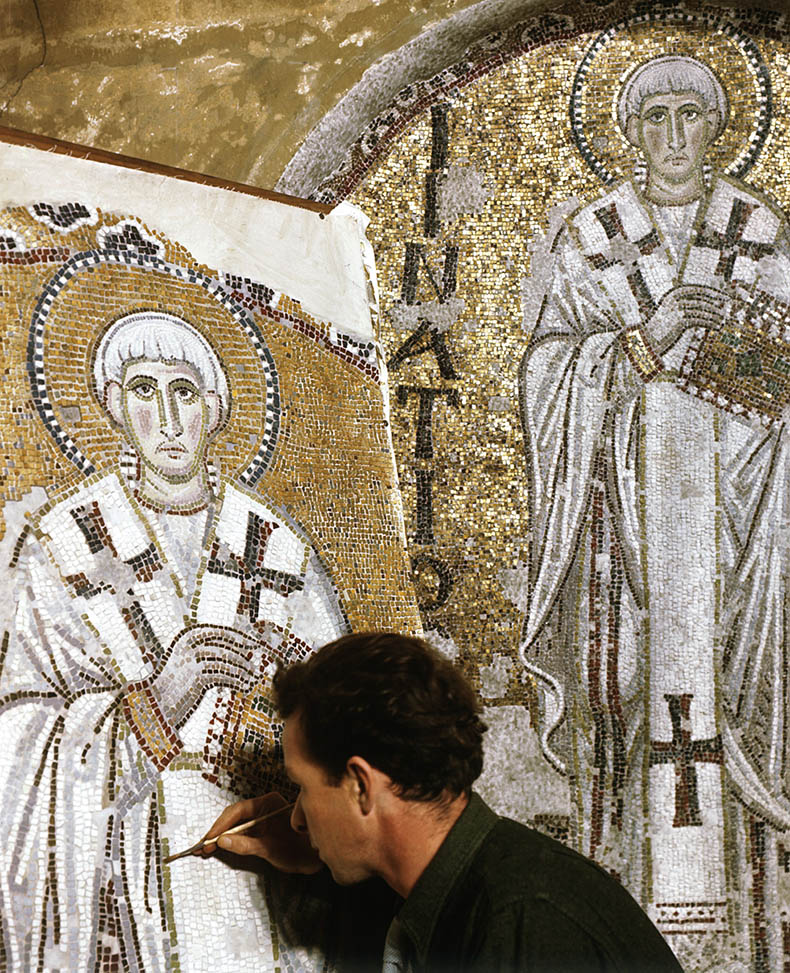
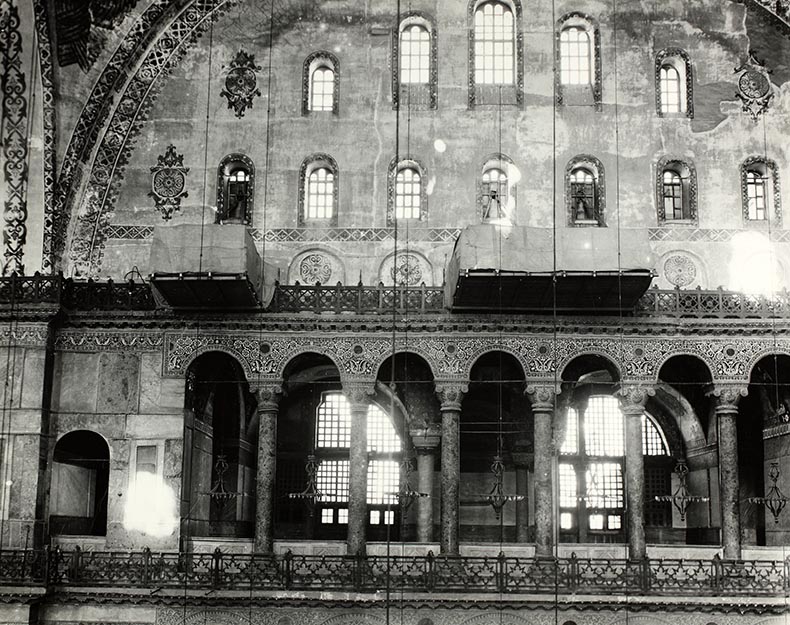
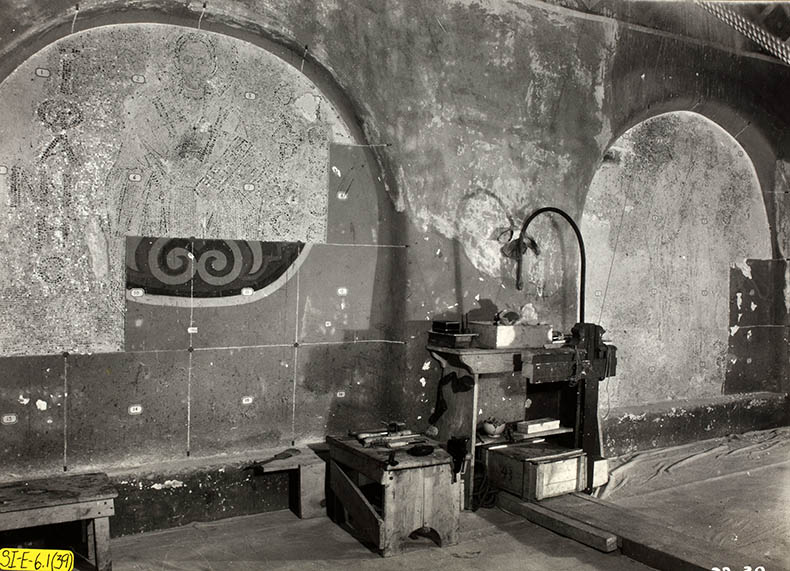
There were originally 14 portraits of the church fathers - 7 one each side. All of them survived up until the Fossati brothers restoration in the 1840's. During the restoration these mosaics were uncovered from beneath plaster and whitewash. The rather crude watercolors you see below where hastily prepared on the spot, as scaffolding was moved around the church. It happened so quickly that there were very few witnesses and no foreign press reports that I have been able to find. A German named Saltzenberg made more drawings and watercolors, but he arrived too late in the restoration to document everything that was being uncovered.
Unfortunately, most of the mosaics that survived in Hagia Sophia for a thousand years were destroyed by the Fossati restoration. For example, of the 14 surviving Church Fathers in 1847 only three were found by the Byzantine Institute. What happened to the other 11 that had been there 100 years earlier?
The Fossati's recovered the mosaics with a layer of plaster followed by a layer of oil paint. For the first time ever in the history of Hagia Sophia this sealed in moisture behind the oil painted surface. The painted layer started pealing all over the church almost immediately. It was obvious what was happening - it has been documented in 19th pictures of Hagia Sophia. The oil permeated the plaster underneath it. Vast areas of mosaic fell away, probably in the 1894 earthquake - a 70-80% loss of everything that had survived. What a disaster and a huge loss for Byzantine art and world culture!
Above are four new pictures of restorers from the Byzantine Institute working on the mosaics mentioned below in 1940. Here you can see the scale of the figures of Church Fathers, who are life-sized. The Fathers are rather coarsely drawn. They could only be seen from across the nave on the opposite side, never up close so a simple drawing would easier seen. The lowest picture shows where they were removing the Fossati plaster and paint that covered them. You can see their tools neatly laid out on the bench in the middle. The color picture shows an artist making a replica of one of the mosaics. A few years ago pictures of Hagia Sophia showed that the mosaics were being damaged by rain leaking from windows above them. I hope that problem has been fixed. Echos of the past!
The team of mosaic artists who made the icons of the Church Fathers were commissioned by the church. Obviously they would have all been men and there would have been 10-20 working on this project. It is not likely that they were monks, just professional craftsmen for hire. Monks could be difficult to direct- especially on spiritual issues. They were under powerful abbots who were used to directing their monks on everything. The deacons and clergy would have insisted on being able to direct the workman in the style and subject matter, even picking the prototypes. They probably were working for the church full time working on Hagia Sophia and other churches. Once they finished these mosaics they probably went on to do more in the church. Mosaics were put up during summer months because of the need for the plaster layers under the mosaic to dry properly. Teams were divided into groups based on what they did. There would have been plasterers, people who organized and managed the colors and quantities of mosaic cubes (a very important technically challenging job) and made them ready for the artists, people who managed the tools, the artist and then workmen who finished the mosaics by polishing. The men who made the mosaics would have done their own drawings and underpainting. There would have been masters and apprentices. Generation to generation the skill set of the team would have increased. Teams might have been family based. The work would have taken around two months to complete all 14 figures.
Since the publication of this report on the mosaics of the Tympana scholars have drawn more attention to the location of the church fathers in relationship to the green Verde Antico "rivers" which have been laid across the nave. These were used as markers for processions in the church, which were always an important part of the liturgy of Hagia Sophia. These saints would have been associated with places in the service for special hymns, prayers and incensing by participants in the processions. The inscriptions are large and easy to read so you would not make a mistake in addressing prayers or veneration to the wrong saint. In Byzantine times the big bulky wooden balconies were not there making the Church Fathers much easier to see. They would have appeared like saints in heaven, looking down upon the worshipers in the church below. This effect would have been made stronger by the vast fields of plain glittering gold mosaic, which has almost entirely vanished to be replaced by dark, dull paint and (hideous) ornament.
Bob Atchison
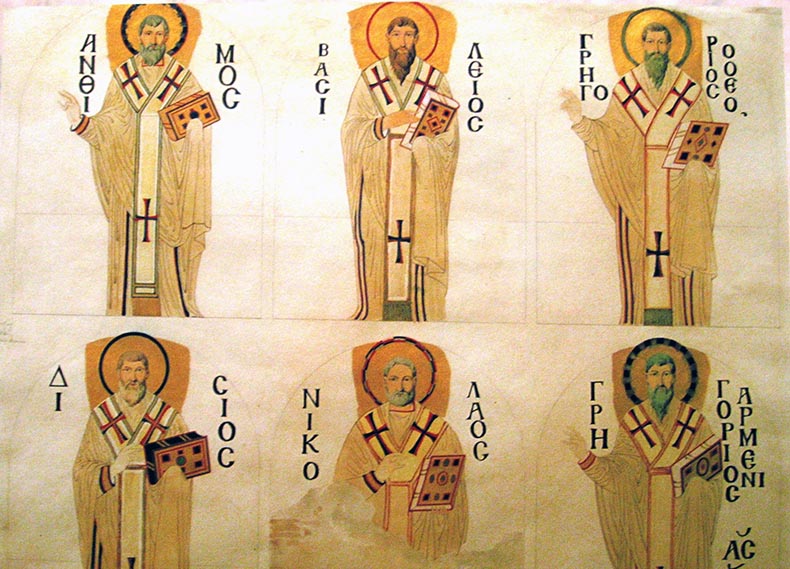
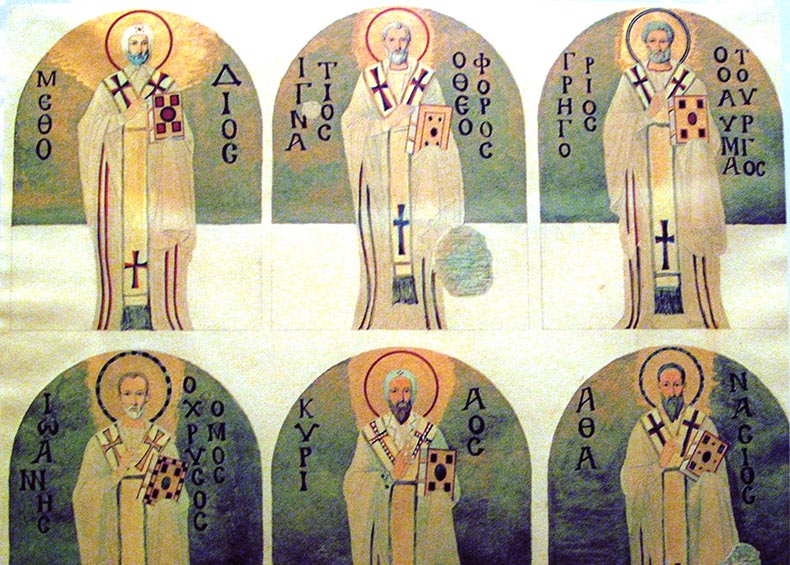
DESCRIPTION OF THE MOSAICS - THE CHURCH FATHERS
All the Fathers of the north tympanum were represented in the same attitude: the right hand held in front of the breast in a gesture of blessing, the left hand, covered by a fold of the chasuble, supporting a book of Gospels. In the south tympanum, as we know from the Fossati and Salzenberg drawings, a variation of attitudes was possible in that some of the Fathers had their blessing right hand extended, while others held it in front of the breast. This could not be done in the north tympanum: if the Fathers had their right arm extended, it would have been pointing westward, away from the altar of the church. Apart from differences of headgear, all the Fathers were dressed in the same vestments, namely a tunic (sticharion) with vertical red and blue clavi, a chasuble (phelonion) and an omophorion decorated with crosses. The surviving figures are summarily finished toward the bottom, that part being hidden from view by the projecting step of the niches. As a result of this the bishops' slippers are barely indicated.
ST. IGNATIUS THE YOUNGER
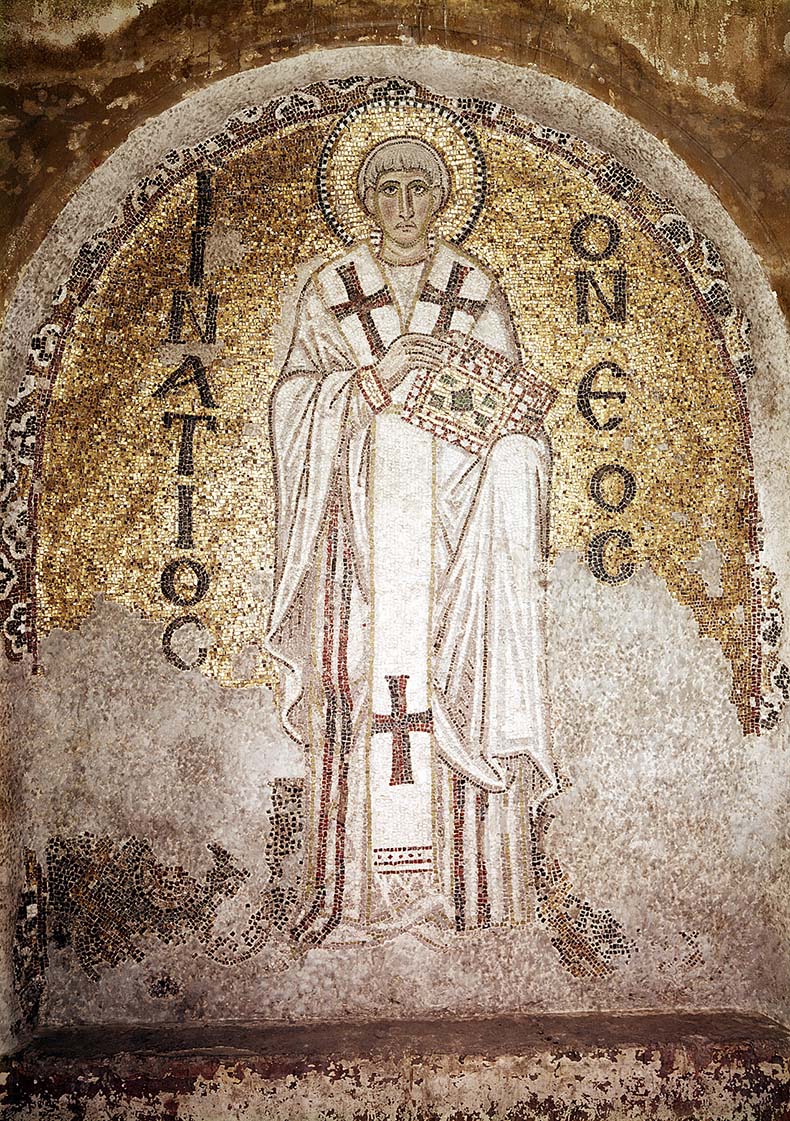 Background: The entire figure including the nimbus is outlined with two rows of gold cubes, as is also the entire panel inside the decorative frame. The letters of the inscription are outlined with a single row of gold cubes. The background is set flush with the surface. There is a sprinkling of silver cubes in the background, roughly 8 to 10 percent of the total. The average size of the gold tesserae is 6 x 8 mm.
Background: The entire figure including the nimbus is outlined with two rows of gold cubes, as is also the entire panel inside the decorative frame. The letters of the inscription are outlined with a single row of gold cubes. The background is set flush with the surface. There is a sprinkling of silver cubes in the background, roughly 8 to 10 percent of the total. The average size of the gold tesserae is 6 x 8 mm.
Inscription: IGNATIOS NEOS - The letters are in different values of dark blue and purplish black glass. The initial iota is dotted, but because of lack of space, there is only one dot on the right side instead of the usual two.
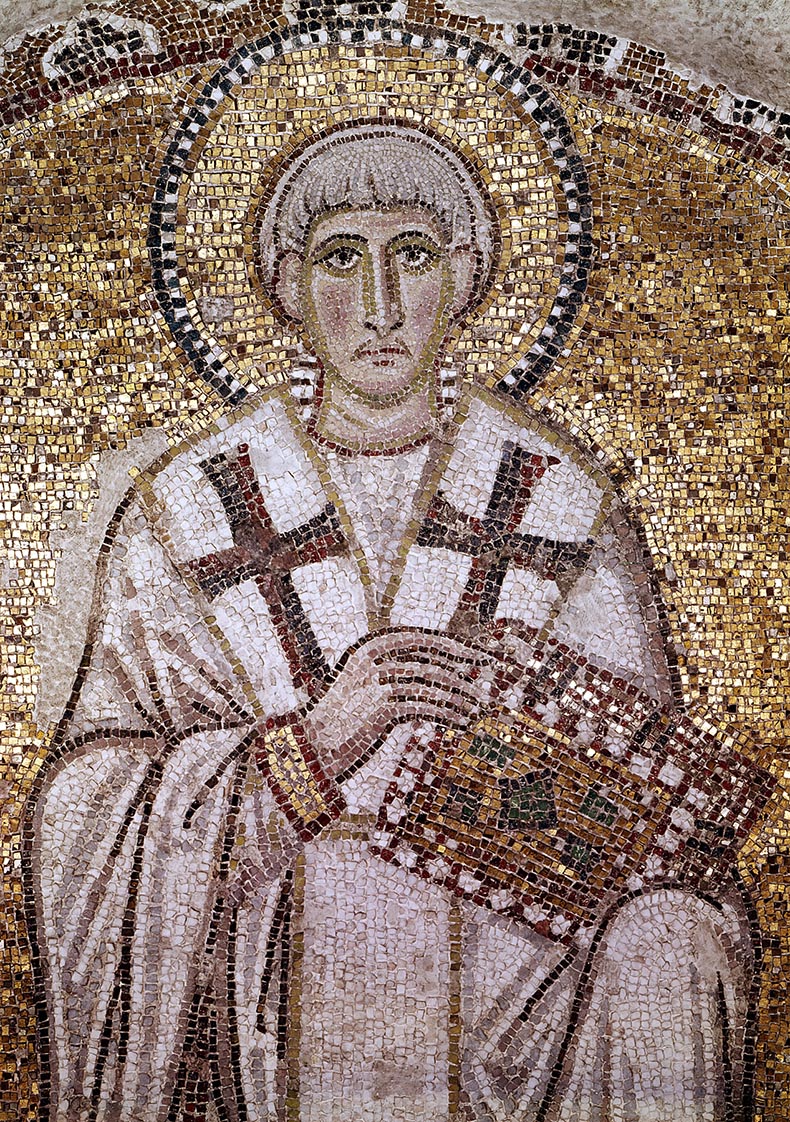
Nimbus:
The outline of the nimbus consists of an outer row of turquoise glass and an inner row of turquoise cubes alternating with cubes of white limestone. The inner circumference of the nimbus and the head are trimmed with a single row of gold set flush with the vertical surface, whereas the field of the nimbus consists of angled gold cubes in horizontal rows. The field of the nimbus does not contain any silver cubes. The head is slightly sunken with regard to the nimbus because of the smaller size of tesserae used in the former.
Head: Ignatius is wearing a skull-cap outlined with one row of "bottle glass." The skull-cap itself is of white marble. Its inner border is made of a single row of light purple glass which also outlines the hair above the forehead and defines tufts of hair. The hair is brushed forward and is rendered in white marble shaded with grey marble. The flesh is in three tones: pink, creamy-yellow and white marble. The pink is in two values, one pure pink, the other having a slightly brownish tinge. Shadows on the flesh are in two values of green glass (yellow-green and light green) and two values of olive green.
The ears and neck are outlined in dark red glass. The eyebrows are of dark purple glass where they converge on the bridge of the nose and of a lighter purple in the region of the temples. The upper eyelashes, the pupils and irises of the eyes and the nostrils are in dark purple glass. The whites of the eyes are of white limestone on the spectator's right side and of grey marble on the left. The shadow under the lower eyelid is in olive green and light green, while above the upper lid it is light green.
The ridge of the nose is lit down the center line with white marble. Next to this, on the spectator's right, is a vertical row of brownish pink marble. The shadow on the right is in olive greens, on the left in light greens. The lobes and tip of the nose are in creamy yellow marble. The crease lines on either side of the mouth are olive green. The parting of the lips and the line below the lower lip are dark red glass. The lips now show as white marble, but the tesserae in them were originally dipped in vermilion colored lead paint. The size of the tesserae used in the head range from 2mm. square to 6mm.square.
Hand: The tesserae used here are much larger than in the head. Flesh tones: white, pink, and brownish pink (all marble) outlined with "bottle glass."
Gospel Book: This is slightly trapezoid in shape. The cover has a red border studded with "pearls," the latter consisting of three or four tesserae of white limestone set in clusters. The cover itself is gold, the tesserae being angled in rows aligned with the axis of the book, and it has an inner border consisting of a single line of red glass. The cover is further decorated with five rectangular emeralds, of which the center one (set in diamond position) and the two bottom ones have a blue glass outline, whereas the two top ones have no outline. The clasps are in dark blue glass; the pages are indicated by alternating lines of silver and dark red glass.
Omophorion: This is outlined with one row of yellow-green glass and consists of white limestone except for a barely perceptible line of white Proconnesian marble all round the edges. The omophorion is decorated with three crosses, two on the shoulders and one below the knees: these are made of alternately red and blue glass in each arm. The bottom border of the omophorion consists of three single lines of red glass: between the first and second lines from the top is a series of red pellets. Finally, there is a white fringe in three knotted tassels contrasting with the purple-grey shadow of the sticharion.
Phelonion: The lighted parts are in white limestone, the shaded parts in grey marble and light purple stone. Outlines and fold-lines are in "bottle glass."
Sticharion: The lighted areas are in white marble and limestone, the shaded areas in grey and purple stone. The outline is yellow-green glass and the same material goes into the folds, especially near the silhouette. There are two pairs of vertical clavi, one on each side of the figure, made of red and blue glass, the blue being used in part to suggest shadow, as, e.g., below the knee. The coloring of the sticharion is differentiated from that of the phelonion in that, 1. Its white is largely marble instead of limestone; 2. It is outlined in yellow-green, not with "bottle glass." The sticharion has a cuff of gold embroidery. This is outlined with red glass. Within the outline is a gold rectangle containing a row of gold cubes set diamond-wise on a purplish stone background. The "collar," visible on either side of the neck, is in alternating horizontal rows of "bottle glass" and white limestone.
Horizontal Decorative Band: There is a diamond on either side of the figure; the intervening rosette must be visualized as being behind the figure. The diamond on the right is almost completely destroyed; so our description applies to the one on the left. The ornamental band, including its upper border of two rows of silver cubes (originally there may have been four) is 0.55 m. high. The background is of loosely set blue glass. The diamond has an outer rectangular frame of gold four rows wide. The field within the frame is of mixed light blue and turquoise glasses and contains a silver disk within which is a more or less quatrefoil figure in red glass. To each side of the diamond is attached a semicircular silver ring filled with red glass and containing a stepped figure in gold. The mosaic peters out into unset plaster about 7 cm. above the step of the niche.
Reveal Ornament: A double row of dark red glass, interrupted by the crown of the nimbus, surrounds he entire panel. The reveal ornament, preserved only in fragments, consists of little quatrefoils (10 to 12 cm. high) of dark blue glass having at their center clusters of white limestone cubes. The quatrefoils are outlined with white limestone or, in a few cases, partly with silver. The background is gold with a sprinkling of silver. The depth of the reveal, measured vertically, is 12 cm.
ST. JOHN CHRYSOSTOM
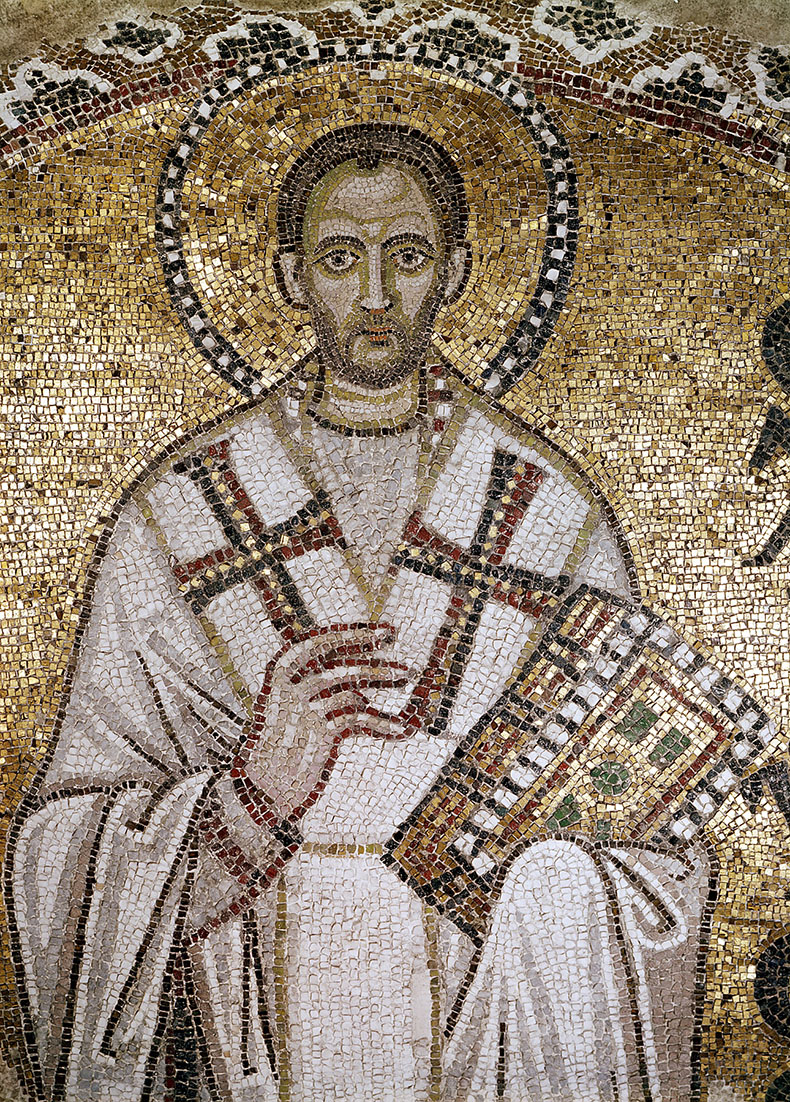 Background: Same characteristics as in the case of St. Ignatius the Younger, except that the proportion of silver cubes is smaller (about 2 percent of the total).
Background: Same characteristics as in the case of St. Ignatius the Younger, except that the proportion of silver cubes is smaller (about 2 percent of the total).
Inscription: IOANNIS 0 Initial iota II CHRISOSOTOMOS. dotted, the two nus in in The letters are made of dark blue and dark ligature. purple glass.
Nimbus: In three rows of dark blue and dark purple glass tesserae, the outermost and innermost being solid, while in the middle one the dark glass tesserae alternate with tesserae of white limestone. The field of the nimbus is of gold, without any admixture of silver, laid concentrically. The head and collar are outlined with a single row of gold. Where the nimbus touches the shoulders the first cube of its innermost ring is gold instead of dark blue so as to allow the silhouette of the shoulders to tell more clearly.
Head: The hair is outlined along its outer and inner circumferences with "bottle glass." The main mass of the hair is in light purple glass with a few accents of "bottle glass." There is a lock of hair in the middle of the forehead. The beard is in light and medium purple glass without a dark outline.
The flesh tones are in three kinds of marble: white, cream, light pink, medium pink. The shadows are in three values of green on the spectator's left and two values of olive on the right. The pupils of the eyes are dark purple glass, the irises light purple. The whites are in cream-colored marble lit on the spectator's right side with a couple of white limestone cubes. The tear ducts are indicated by means of single cubes of vermilion glass. The upper eyelids are dark purple, the lower dark olive glass. The heavy eyebrows are in two rows, the upper one purple, the lower one dark olive. The shadows round the eyes are yellow green. The nose consists of a vertical row of white cubes in ridge terminating a large pear-shaped tessera (also white) on the tip and three cubes of vermilion glass. Following the line of the ridge on the spectator's right are a row of medium pink marble and a row of dark olive glass. On the left of the ridge is one row of light pink marble. The nostrils are indicated by means of two dark purple cubes on each side. The ears are in white and cream marble outlined with "bottle glass." The concha is shaded in light purple. The lips consist of single lines of vermilion glass. The parting of the mouth and the shadow under the lower lip are dark purple. The slight moustache is in medium purple and different values of olive. The neck is outlined with bottle glass. The flesh is in white, cream, and light pink marbles with light green shadows. The tesserae used in the head are from 2 to 6 mm. square as also in the case of St. Ignatius the Younger.
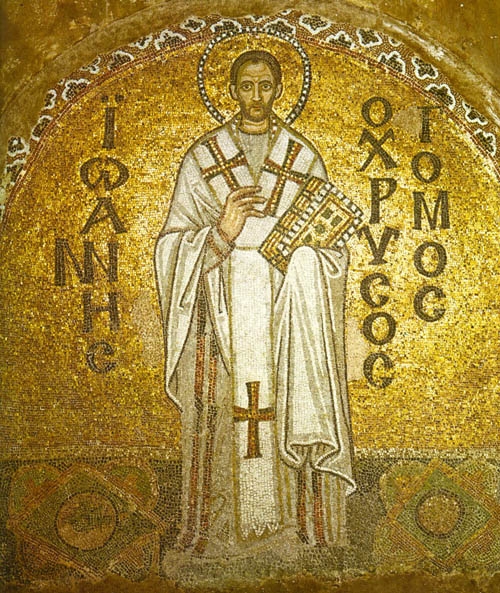 Hand: Clumsily drawn, it is outlined all round with dark red glass. The flesh tones are cream and medium pink, highlighted with white marble. The cubes are quite big, up to 12 mm. in length.
Hand: Clumsily drawn, it is outlined all round with dark red glass. The flesh tones are cream and medium pink, highlighted with white marble. The cubes are quite big, up to 12 mm. in length.
Gospel Book: The cover has an outer border consisting of a row of "pearls" (groups of limestone cubes) separated from one another by dark purple l one circular, the two upper ones rectangular, the two lower ones of somewhat indeterminate shape. The outline of the book as well as its four clasps are in dark purple; the pages are in alternate lines of gold and red.
Omophorion: Outlined with one row of light green and yellow-green, inside which is one row of white Proconnesian marble turning to grey marble at a point a little above the knees. Except for this double outline, the material of the omophorion is rendered in white limestone. The three crosses are alternately red and blue in each arm, the center lines being indicated by widely spaced gold tesserae set diamond wise. The lower end of the omophorion has no ornamental border, merely a fringe of three tassels.
Phelonion: Highlights in white limestone, shaded areas in grey marble and purplish stone,the latter spectator's right. Outline and fold lines in "bottle glass."
Sticharion: The lightest color used is grey Proconnesian marble; shaded areas in light purple and khaki-brown stone; fold-lines light green glass. There is a double clavus on each side in two to three vertical rows of dark blue and dark red glass, blue being also used to indicate shadow on the clavi, namely, below the phelonion, the fold over the figure's right knee, and folds over the feet. Among the red tesserae are a few of terra-cotta and one of grey marble that were dipped in red lead paint. In the outermost clavus on the spectator's left there is, just below the knee, a small area of unset plaster.
Cuff: Large, widely-spaced cubes of grey marble outlined with a double row of dark red glass. A small corner of shadow inside the cuff is indicated by a cluster of dark blue cubes next to the wrist.
Collar: On the spectator's right it is in alternating rows of white limestone and red glass. On the left, instead of red glass, there are two small patches of plaster painted a dark earth-red.
Slippers: These are not outlined and are therefore barely visible. They are made of grey, purple, and khaki-brown stones.
Horizontal Decorative Band: Height 0.54 m. from the step of the niche; outlined at the top with four rows of silver tesserae. The two diamonds, which are very untidily drawn, have an outer rectangular frame of three to four rows of gold, inside which is an area filled with emerald, light green, blue, and turquoise glasses mixed. At the center of the diamonds is a circular disk outlined with one row of blue glass on the spectator's left and two on the right. The field of the disks is silver. The one on the left encloses a stepped square, the one on the right something resembling a leaf, both in green. The semicircular rings attached to the sides of the diamonds are in two to three rows of silver. They are filled with mixed green tesserae and contain a stepped figure in gold. The general background of the decorative band is in dark blue and purple glass except on the right of the figure where it is mostly in dark blue Beykoz stone: the supply of glass tesserae must have been exhausted. The mosaic peters out into unset plaster 6 to 10 cm. above the step.Reveal Ornament: Width, including red borders, 0.27 to 0.29 m. This is a diaper pattern and is here preserved only on the right side of the niche. There remain five diamonds placed end to end, each one about 0.25 m. high. Outline of diamonds in three rows of gold with a sprinkling of silver cubes; inside of diamonds red glass. The diamonds contain little green quatrefoils outlined against the red with one row of gold. The triangular spaces between the diamonds are dark blue mixed with dark purple and contain gold stepped forms with centers consisting of two to four green glass cubes. The lowest diamond has an inside field of terracotta instead of red glass.
Ornament between Niches 4 and 5: Here we have one rosette pertaining to the horizontal decorative band. Height 0.54 m. including upper border consisting of four rows of silver; width 0.64. The arms of the X (each terminating in a lily) and the outer outline of the four "hearts" are in three rows of gold containing a few silver cubes. The upper and lower hearts are filled with mixed turquoise and blue glass; the two lateral hearts with large cubes of terracotta and a few stray cubes of red glass. The general background is in dark blue and purple glasses.
Above this ornament plain gold mosaic survives to a height of about 0.30 m. (measured along the center line). It is set flush with the surface and contains a liberal sprinkling of silver, about 8 percent of the total.
ST. IGNATIUS THEOPHOROS
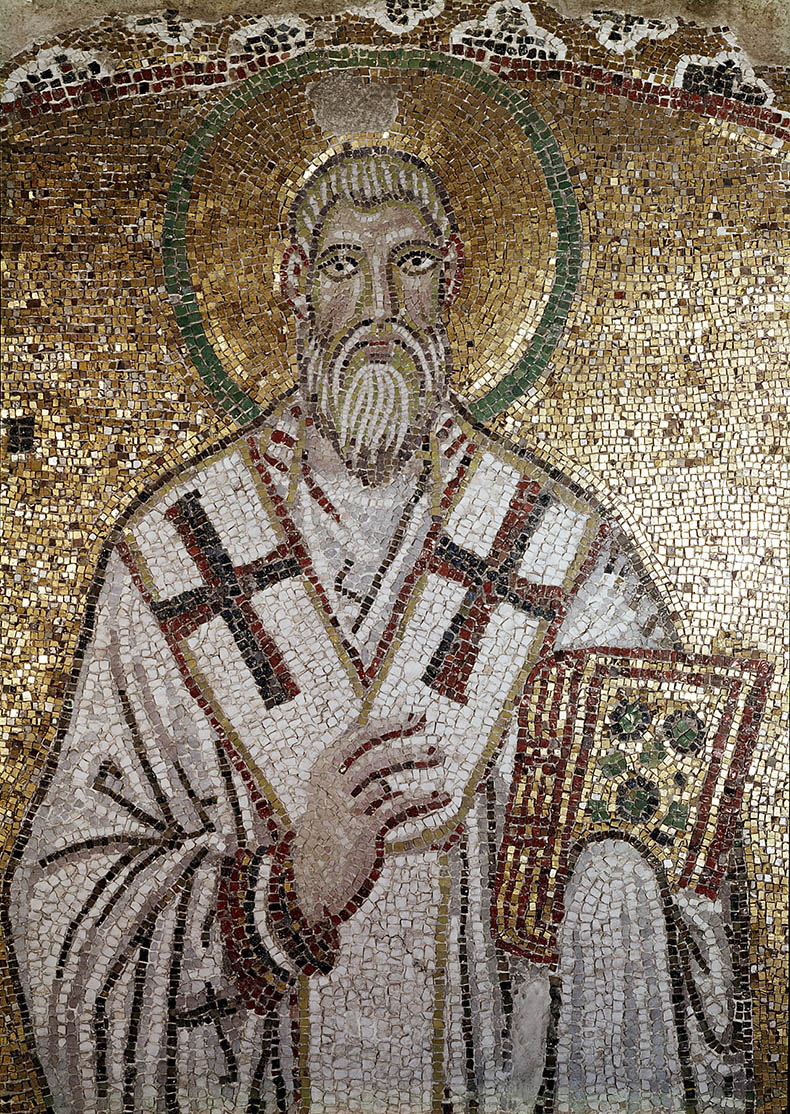 Background: The surface of the mosaic is rather uneven as also in the case of St. Athanasius. Outlining of figure and letters as in the other panels. The proportion of silver cubes mixed with the gold is about 9 percent and there are also five or six red glass cubes scattered at random. To the right of the figure, below the inscription, is a small cross of which only the top and right arms are preserved. The cross is outlined with a single row of "bottle glass" and is filled with plain gold.
Background: The surface of the mosaic is rather uneven as also in the case of St. Athanasius. Outlining of figure and letters as in the other panels. The proportion of silver cubes mixed with the gold is about 9 percent and there are also five or six red glass cubes scattered at random. To the right of the figure, below the inscription, is a small cross of which only the top and right arms are preserved. The cross is outlined with a single row of "bottle glass" and is filled with plain gold.
Inscription: IGNATIOS || THEOPHOROS. Initial iota dotted. The letters are made of dark blue and purple glasses; a couple of red glass cubes have also been inserted into them.
Nimbus: The field of the nimbus is in pure gold laid concentrically. The outline consists of two solid rows of emerald green with a few cubes of light green thrown in. The head is slightly sunken with regard to the field of the nimbus.
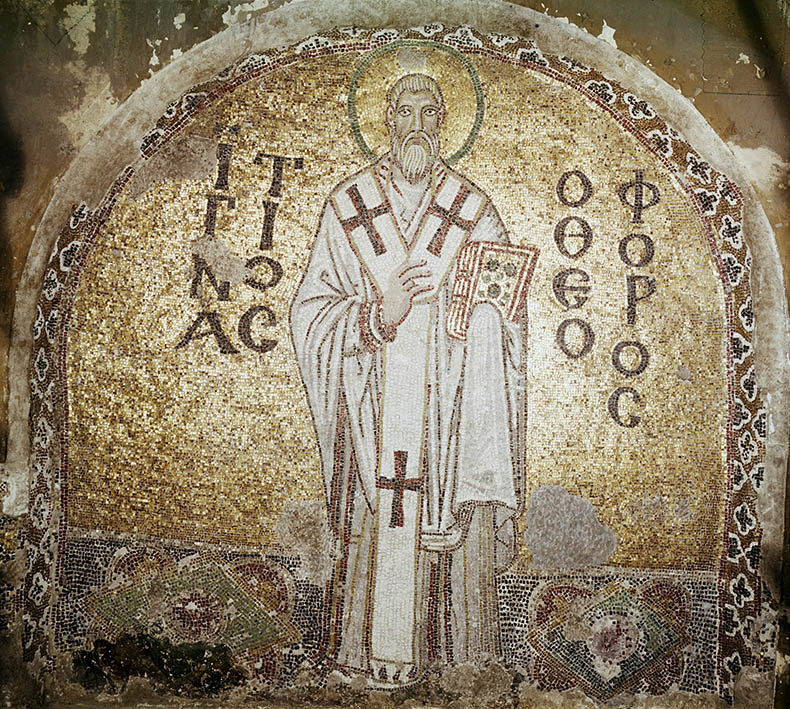 Head: The hair has an outer and an inner outline in medium purple glass and is drawn in vertical lines, alternately light green glass and white marble. The beard has been treated essentially in the same way: it is outlined and shadowed with light and medium purple as well as olive glass, while the strands of hair are of white marble alternating with light and yellow-green glass. The flesh tones are in white, cream, and one value of pink marble. The face is outlined with one row of light and yellow-green, the same colors being also used for shading, except in the lower part of the cheeks which are shaded in olive. The size of the tesserae used in the head is slightly larger than in the other two panels that have been described, the average being 4 x 6 mm. The pupils of the eyes consist of a single cube of dark purple glass. The whites are of cream marble lit on the spectator's right side with white limestone. Upper lashes dark purple, lower lashes dark olive. Eyebrows light and medium purple. Shadow between eyebrow and upper eyelash light green. The ridge of the nose is formed by one vertical row of white marble. This is followed on the spectator's right by one row of pink marble and one row of olive glass; on the left, by one row of cream marble and one row of light green glass. Nostrils dark purple. The ears are in the same flesh tones as the face and are outlined in red glass. The concha of the right ear is shaded in yellow-green with a couple of red cubes to mark deeper cavities. The lips are of pink marble, the parting being red glass. The shadow at the corners of the mouth is dark purple, whereas under the lower lip it is medium and light purple. A small portion of the neck is visible to the left of the beard from the spectator's point of view. It is in the same flesh tones as the face.
Head: The hair has an outer and an inner outline in medium purple glass and is drawn in vertical lines, alternately light green glass and white marble. The beard has been treated essentially in the same way: it is outlined and shadowed with light and medium purple as well as olive glass, while the strands of hair are of white marble alternating with light and yellow-green glass. The flesh tones are in white, cream, and one value of pink marble. The face is outlined with one row of light and yellow-green, the same colors being also used for shading, except in the lower part of the cheeks which are shaded in olive. The size of the tesserae used in the head is slightly larger than in the other two panels that have been described, the average being 4 x 6 mm. The pupils of the eyes consist of a single cube of dark purple glass. The whites are of cream marble lit on the spectator's right side with white limestone. Upper lashes dark purple, lower lashes dark olive. Eyebrows light and medium purple. Shadow between eyebrow and upper eyelash light green. The ridge of the nose is formed by one vertical row of white marble. This is followed on the spectator's right by one row of pink marble and one row of olive glass; on the left, by one row of cream marble and one row of light green glass. Nostrils dark purple. The ears are in the same flesh tones as the face and are outlined in red glass. The concha of the right ear is shaded in yellow-green with a couple of red cubes to mark deeper cavities. The lips are of pink marble, the parting being red glass. The shadow at the corners of the mouth is dark purple, whereas under the lower lip it is medium and light purple. A small portion of the neck is visible to the left of the beard from the spectator's point of view. It is in the same flesh tones as the face.
Hand: Outlined only on underside of palm and fingers in red glass which is also used to indicate the nails. The flesh is in cream and pink marble with a few white marble cubes on the knuckles and the back of the hand. The ring finger is bent to join the thumb that is hidden from view.
Gospel Book: The entire book is outlined in red (double row on spectator's right). The cover is gold with a sprinkling of silver and is decorated, within a further red border, with round emeralds disposed in an X. We are to imagine five of these, but the two lower ones are hidden by the Saint's covered left hand. The round jewels have an outline of blue glass. Round the central jewel is a ring of smaller ones, of which four are emerald mixed with light green (not out- lined) and two are blue. The pages of the book are alternately red and gold and there are two red clamps.
Omophorion: Outlined for the most part in red glass. Within the red line is a complete outline in yellow-green. The material of the garment is in white lime- stone: there is no line of white marble along the edges. The three crosses are alternately red and blue in each arm. The blue is mixed with purple and a few stray cubes of green and "bottle glass." The omophorion terminates in three triangular white tassels.
Phelonion: Outline and folds in "bottle glass." Highlights white limestone on a field of grey Proconnesian marble. Shadows in light purple stone.
Sticharion: Grey-blue Proconnesian marble and light grey stone. Outlined on spectator's right with one row of "bottle glass," on the left with the red line of the clavus. Shadow lines in light greens. Two red and blue clavi on each side, the blue for the most part running parallel to the red, and not used to suggest shading.
Cuff: Rather haphazard arrangement of stripes: one of white limestone in the middle, two stripes of alternating red and gold tesserae, the rest red and blue.
Collar: Alternating rows of white limestone and red glass.
Slippers: Only his right slipper is visible. It is in unset plaster outlined in light green glass. The mosaic peters out 5 to 14 cm. above the step of the niche.
Horizontal Decorative Band: Height 0.49 to 0.51 m. from step of niche. Upper border consists of three (not four) rows of silver. The two diamonds (the right one is noticeably smaller than the left one) have a quadrilateral frame of three rows of gold enclosing an area of light green mixed with a considerable number of light blue, dark blue, and emerald cubes, especially in the diamond on the right. At the center of each diamond is a silver disk containing a cross-on-square form in red glass. The semicircles attached to the four sides of each diamond have a silver border two rows wide. They contain stepped forms in gold on a red glass ground. The lower part of the diamond on the left (fig. 31) including part of the two lower semicircles and a section of background has been repaired in frescoed plaster, presumably in the late Byzantine period. The patch, crudely plastered over the surviving mosaic, is painted in blue, white (for silver), red, yellow, (for gold) and green. Furthermore, there is a small patch of twelve light blue glass cubes (mixed shades) in the horizontal silver border to the left of the figure, where the upper left semicircle of the diamond touches the border. This, too, may be a repair.
Reveal Ornament: Outlined on both sides with double row of red. Quatrefoils, outlined with one row of white limestone, consist of dark blue and dark purple glass with a few stray cubes of other colors. They have no centers. The background is gold with a small admixture of silver.
Ornamental Surround of Niche: This survives only on the left side to a height of about 0.65 m. from the step of the niche, and consists of the same diaper pattern that has been described earlier, except that the quatrefoils within the diamonds are blue with an admixture of emerald green, while the gold stepped forms in the triangular spaces have no centers.

THE LOCATION OF THE BISHOPS
The location of the mosaics of the bishops on the north and south walls of the nave may be explained in one of two ways, viz., either by the lack of suitable wall space in the apse, or by the consideration that in the late ninth century the emplacement of bishops' portraits within a given church decoration had not yet been determined. The apse of St. Sophia is indeed entirely revetted with marble up to the level of the cornice, thus affording no room for representations of bishops below the zone devoted to the Virgin Mary and archangels. But even had such room been available, we have no guarantee that in the ninth century he bishops would have been placed in the apse in preference to another part of the church. Early Christian antecedents do exist for the location of bishops - at any rate, local bishops - in the apse (e.g., S. Apollinare in Classe); and certainly there are examples of this practice by the tenth century. But even among monuments of the ninth to the eleventh centuries we often find portraits of bishops scattered more or less at random: at Goreme, chapel 1 (El Nazar) in the pendentives of the dome, chapel 3, on the pier separating the nave from the narthex; Goreme, chapel 4a, in the east bay of the nave; Irhala, Ylanl kilise, on the east, south, and north arches of the nave, etc. Even at Hosios Loukas, whilst SS. Gregory Nazianzen and Athanasius are in the sanctuary proper, SS. Basil, John Chrysostom, Gregory Thaumatourgos, and Nicholas are in the nave; while at the Anargyroi of Kastoria (first layer: eleventh century?) SS. Basil and Nicholas are in the narthex. It is only from the end of the eleventh century onward that the placing of bishops in the sanctuary and, in particular, in the lower register of the apse, becomes de rigueur.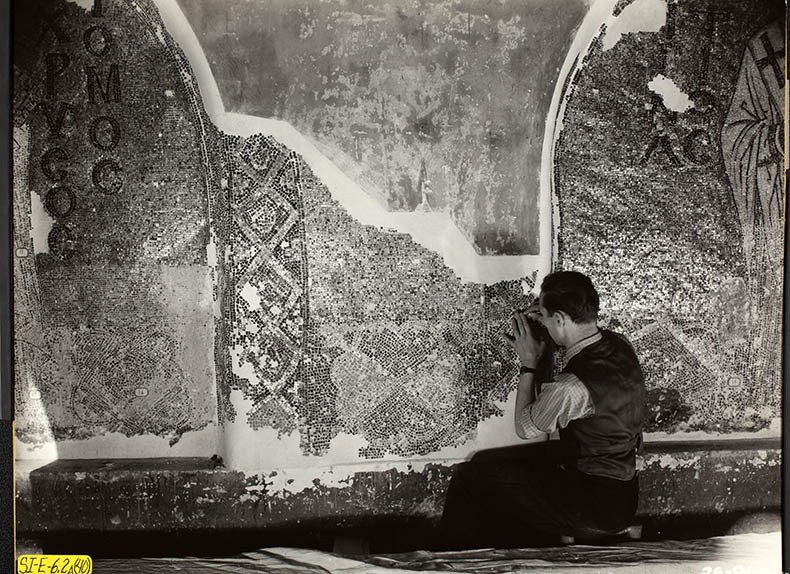
A more complex problem is posed by the selection of Fathers represented in both tympana. Turning to our list, we find in it, on the one hand, a number of highly venerated doctors of the Orthodox Church,whose presence here requires no justification (SS. Basil, Gregory Nazianzen, Dionysius, Nicholas, Gregory Thaumatourgos, John Chrysostom, Ignatius Theophoros, Cyril, and Athanasius); on the other hand, a smaller number of bishops whose choice must have been dictated by special circumstances (SS. Anthimus, Gregory of Armenia, Ignatius the Younger, Methodius). To be sure, Byzantine practice did not impose in this respect any rigid formula: every case was, to some extent, individual. For the sake of comparison, it may be helpful to quote here a few representative examples. Thus, the iconographic compendium of "Ulpius the Roman" (ninth/tenth century) includes SS. Dionysius, Gregory Nazianzen, Basil, Gregory of Nyssa, Athanasius, Chrysostom, Cyril of Alexandria, Cyril of Jerusalem, Eustathius of Antioch, Tarasius, and Nicephorus (in all, eleven bishops). In the apse of St. Sophia, Kiev (1042-46) we find the following from left to right: SS. Epiphanius, Clement of Rome, Gregory Nazianzen, Nicholas, Basil, Chrysostom, Gregory of Nyssa, Gregory Thaumatourgos. At Hosios Loukas, as we have said, SS. Gregory Nazianzen, Athanasius, Basil, John Chrysostom, Gregory Thaumatourgos, and Nicholas are given preferential treatment, while another sixteen bishops are crowded into the vaults and arches of the prothesis and the diaconicon (SS. Sylvester, Cyprian, Spyridon, Achilios, Anthimos, Eleutherios, Polycarp, Antipas, Gregory of Nyssa, Philotheos, Hierotheos, Dionysius, Ignatius Theophoros, Gregory of Armenia, Cyril of Alexandria, Clement). At Daphni we find Nicholas, Gregory Thaumatourgos, Gregory of Agrigento, Sylvester, Anthimos, Eleutherios, and Aberkios. These few confrontations show us not only the diversity in the choice of bishops from one church to another, but the absence from St. Sophia of some widely revered Fathers, such as, e.g., Gregory of Nyssa.
In searching for a principle of selection, we must begin by ruling out one that would give pride of place to the local Church of Constantinople. The respective sees of the bishops portrayed are the following:
1. Unknown
2. St. Anthimus: Nicomedia
3. St. Basil: Caesarea of Cappadocia
4. St. Gregory: Nazianzus
5. St. Dionysius: Athens
6. St. Nicholas: Myra
7. St. Gregory: Armenia
8. St. Ignatius the Younger: Constantinople
9. St. Methodius: Constantinople
10. St. Gregory Thaumatourgos: Neocaesarea
11. St. John Chrysostom: Constantinople
12. St. Ignatius Theophoros: Antioch
13. St. Cyril: Alexandria
14. St. Athanasius: Alexandria
While, therefore, Constantinople is a little better represented than the other sees, its preponderence is too slight to be meaningful. Nor can we discover any trace of a geographical distribution such as exists at St. Sophia, Ohrid, where the patriarchs of Constantinople occupy the central apse, while the popes of Rome are relegated to the south lateral apse. The only significant observation we may make under this heading concerns the absence of any Roman pope (e.g., Clement or Sylvester) or, for that matter, any other prelate of the Western Church: all the bishops listed above are Eastern ones. Note, however, that of the four Eastern patriarchates Jerusalem is not represented.
Secondly, we may observe that in the choice of bishops no special emphasis was laid on the suppression of Iconoclasm. In the room above the southwest vestibule of St. Sophia the portraits of the patriarchs Germanus, Tarasius, Nicephorus, and Methodius insistently call to mind the victorious struggle of the Orthodox Church against the Iconoclasts. In the tympana, on the other hand, Methodius alone symbolizes the final liquidation of the heresy. We may conclude from this that at the time when the mosaics of the tympana were made the issue of Iconoclasm had already lost much of its urgency.
Another line of investigation is offered by the liturgical calendar of St. Sophia as we know it from the late ninth and subsequent centuries. The synaxis or special commemorative services in honor of the Fathers represented in the tympana were celebrated in the following places:
1. Unknown
2. Anthimus (September 3): on the north side of the Golden Horn
3. Basil (January 1): in St. Sophia.
4. Gregory Nazianzen (January 25): in St. Sophia and also at themartyrion of St. Anastasia and the church of the Holy Apostles (where the Saint's relics were deposited by Constantine VII).
5. Dionysius (October 3): in St Sophia
6. Nicholas (December 6): in St. Sophia.
7. Gregory of Armenia (September 30): in the martyrion of St. Theodore near the Brazen Tetrapylon.
8. Ignatius the Younger (October23): at the Satyros monastery, on the Asiatic side of the Propontis
9. Methodius (June 14): at the church of the Holy Apostles where his relics lay
10. Gregory Thaumatourgos (November 17): in St. Sophia
11. John Chrysostom (November 13): According to the typicon of the Great Church the procession started at St. Sophia and proceeded,
by way of the Forum, to the church of the Holy Apostles where he service was held. The synaxaria contain no topographical indication. In the fourteenth century the commemorative liturgy, attended by the emperor, was celebrated in St. Sophia.46
12. Ignatius Theophoros (December 20): in St. Sophia.
13-14. Cyril and Athanasius (January 18): in St. Sophia
Thus, of the thirteen Fathers known, eight had their synaxis in St. Sophia.
John Chrysostom was naturally associated with the church of the Holy Apostles where his relics lay; but his inclusion in the series was obligatory and, therefore, raises no problem. We are left with four "special" cases, those of SS. Anthimus, Gregory of Armenia, Ignatius the Younger, and Methodius. We shall consider these later since they have an important bearing on the date of the mosaics under discussion.
Surprisingly enough, the order in which the bishops are arranged appears to be largely haphazard, except that the central position in each tympanum is assigned to a "major" Father, Chrysostom on the north and Gregory Nazianzen on the south. Basil is appropriately placed next to Gregory; the two Alexandrian patriarchs, Athanasius and Cyril, who shared the same feast day, are side by side, as are also the two most recent members of the group, Methodius and Ignatius the Younger. Proximity to the east end of the church does not seem to have been a determining factor.
ICONOGRAPHY
We shall begin with a few general observations which apply to all the figures of the Church Fathers. Byzantine representations of bishops lend themselves to a classification based on costume. In the post-iconoclastic period the earliest group exhibits only three articles of clothing: sticharion, phelonion and omophorion. It is to this group that our mosaics belong. The epitrachelion, a long embroidered scarf that was passed round the neck and reached down to the feet (it was worn under the chasuble) begins to appear in works of art from about the middle of the tenth century onward. A further addition, observable toward the end of the tenth century, is the encheirion, a rectangular piece of fabric attached to the tunic over the right thigh. This was later replaced by the epigonation, a stiff, lozenge-shaped article suspended over the right knee.
Another archaic feature of our mosaics is the use of haloes delimited by a colored ring decorated with pearls. This practice, common in the Early Christian period, disappears from monumental metropolitan painting toward the end of the ninth century, while it tends to persist in the provinces (e.g., Cappadocia and Italy) and in the minor arts. Also significant is the omission of the epithet a agios from the inscriptions: this, too, reflects Early Christian usage, and is shared by a few manuscripts of the ninth and tenth centuries, and some of the earlier decorations in Cappadocia.
ST. IGNATIUS OF CONSTANTINOPLE
Representations of the Patriarch Ignatius are very rare in Byzantine art, the one before us being the earliest and surely the most "authoritative." The head is that of an elderly man as shown by his white hair. The beardless, oval face is rather elongated, the nose decidedly long, the dark eyes big and staring. The complexion is fresh and, except for the wrinkles over the mouth, does not suggest advanced age: indeed, had the hair been dark, we would readily have accepted this as the portrait of a man of about forty. We must also bear in mind that the discoloration of the lips (which were originally red) has made the expression more ascetic and lifeless than was intended. That this representation is based on a genuine portrait made in the Saint's lifetime, is a natural enough assumption. There exists evidence from different periods of Byzantine history that portraits of patriarchs were set up in their lifetime to be occasionally suppressed when this or that patriarch was condemned for heresy. It has further more been suggested that there existed in the Patriarchal Palace a kind of picture gallery which was gradually enriched by the portrait of each successive incumbent. This may well have been so, although it cannot be proved with complete certainty; nor can we say in which part of the palace such a gallery, if it existed, was kept. In the case of two patriarchs who fought Iconoclasm, namely Tarasius and Nicephorus, detailed descriptions of their features, probably derived from painted portraits, have been preserved in written documents. At a later period an extensive series of both patriarchal and imperial portraits was set up in the narthex of St. George of the Mangana.
Ignatius is represented beardless in his mosaic portrait correctly so since he was made a eunuch at the age of fourteen. The accuracy of his other features cannot be verified. Assuming, however, that our mosaic is based on a genuine portrait, it may be worth asking when such a portrait was made. Now, Ignatius was born in 799, the son of the future emperor Michael I (811-13), and served as patriarch from 847 until 858 and once again from 867 until his death on October 23, 877. Our mosaic does not appear to us to depict a man in his seventies: we are more inclined to believe that Ignatius is represented here as he was soon after his appointment in 847, a man of about fifty.
The following other pictures of St. Ignatius are known to us:
1. Chalice in the Treasury of St. Mark's Venice, first half of tenth century. Bust of St. Ignatius, beardless.
2. Menologium of Basil II, cod. Vat. gr. 1613 (979-1025), p. 134. Ignatius, beardless, lying on his deathbed.
3. Same manuscript, p. 420. Ignatius with white hair and beard stands next to the Emperor Michael III at the Invention of the head of St. John the Baptist.
4. Dionysiou, cod. 587 (740), eleventh-century lectionary, fol. 148r. Same scene as in No. 3, Ignatius bearded.
5. Cod. Vat. gr. 1156, eleventh-century lectionary, fol. 262v.67 Small figure of St. Ignatius, bearded. 6. St. Nicholas "of the Roof," near Kakopetria, Cyprus, fresco in prothesis (late eleventh century?). Bust of Ignatius, beardless, dark hair
7. Chronicle of Skylitzes, cod. Matrit. gr. Vitr. 26-2 (late thirteenth century), fol. 76r. Ignatius, bearded, receives the news of his appointment as patriarch.
The representations listed above are of some interest for assessing the procedures of Byzantine painters. An iconographic type of St. Ignatius, distinguished by the lack of a beard and probably by white hair, did exist, but it was so seldom used that very few painters could have known of it. The Kakopetria artist must have been familiar with it, but he probably interpreted the absence of a beard as an indication of youth, and so endowed Ignatius with dark hair. Other painters were less scrupulous and simply created a standard, white-bearded bishop type. It is particularly interesting that both the beardless and bearded variants should occur in the same manuscript, the Menologium of Basil II, although, admittedly, the two miniatures in question are not by the same painter.
ST. JOHN CHRYSOSTOM
The iconography of this very popular Saint has been discussed at length by Otto Demus; so there is no need for us to go over the same ground again. Demus finds that there existed three distinct types of Chrysostom: 1. The "iconic," which is that of a relatively young man having an oval face and a sparse beard, lacking any strongly individual traits. This is the earliest recorded type and is found in frescoes of the seventh and eighth centuries in S. Maria Antiqua, Rome. 2. The "ascetic," which is the dominant type in Byzantine art from the eleventh century onward. Here Chrysostom is almost bald and has a short beard often divided into two points. He has a high bulbous forehead, an aquiline nose, sunken eyes, emaciated cheeks, and a pointed chin. 3. The "humanistic" type represented by our mosaic, the tenth-century reliquary of the True Cross from the treasury of the Sancta Sanctorum in Rome and the fresco in the parecclesion of the Kariye Camii. Here St. John is not bald, though his hair is shown as receding from his high forehead, and his features are more masculine than those of the "ascetic" type. Iconographically, the closest parallel to our mosaic is provided by the afore-mentioned reliquary of the Sancta Sanctorum. The proportions of the figure are a little different in that the mosaic shows a massive, broad-shouldered body terminating in a small head, while the reliquary depicts an elongated and rather narrow body; the two heads are, on the other hand, practically identical.
It may be of interest to quote here the description of Chrysostom given by "Ulpius the Roman," an author writing between ca. 850 and 950, hence more or less contemporary with our mosaic:
"John of Antioch was a man of very short stature who carried a large head on his shoulders, extremely thin, having a long nose, wide nostrils, and a very pale, whitish complexion. The sockets of his eyes were hollow and contained big eyeballs which sometimes glinted pleasantly, although the rest of his expression was that of a man in grief. He had a bald,high forehead marked with many wrinkles. His ears were big, his beard short and very sparse, of a light color due to white hairs."
This description is more applicable to the "ascetic" than to the "humanistic" type. It is interesting, too, that our mosaic should go counter to the text, for, instead of representing a small body with a disproportionately bighead, it shows a big body with a small head. It may be said, however, that in Byzantine art the size and proportions of human figures were a factor of style, not of iconography.
ST. IGNATIUS THEOPHOROS
Ignatius Theophoros, third bishop of Antioch (after Peter and Evodius), was martyred in Rome in the reign of Trajan (98-117). There could thus have been no authentic data for his portrait which, in Byzantine art, is a purely conventional one: he is represented as an old man with white hair and a medium long beard usually terminating in a sharp point. These characteristics remain fairly constant, except that in the Palaeologan period the beard grows longer, while the hair at times becomes less abundant. The only deviant representation known to us is the fresco in the south gallery of St. Sophia at Kiev, where the hair and beard are dark. Ignatius was not portrayed very frequently, but there are enough pictures of him to establish a definite iconographic tradition.
The repertory of ornament exhibited by the mosaics of St. Sophia would deserve a special study. Without going too far afield, we should like to offer a few observations on the motifs we have encountered in the tympana, namely the to the the and the There can be little winged palmette. diamond, rosette, doubt of their sixth-century date since they recur in other parts of the mosaic decoration which we have reason to ascribe to Justinian's reign. In fact, there is a remarkable consistency of ornamental vocabulary throughout the church, the same basic forms being used, over and over again, in various combinations, not only in the mosaics, but also in the carving, the metalwork, and in the opus sectile.
1. The diamond and rosette. These two alternating motifs are found in the bema arch (Phase I),the exedra windows, and the lower part of the ribs of the dome. A greatly simplified version of the same design recurs in the borders of the two square porphyry panels on the west wall of the nave, above the imperial door, and of marble panels in the apse. Another variant was obtained by detaching the X from the rosette and placing the former element in alternation with a diamond: this we find in the ribs of the dome, in the border of the circular medallion at the center of the dome, in the apse windows, in the west gallery (now destroyed), and even in the surrounds of the mosaic crosses in the west bay of the south aisle. It is worth observing that practically the same design occurs in the earliest phase, which may be of the sixth or seventh century, of the mosaics of the church of the Dormition at Nicaea, and in the room above the southwest ramp of St. Sophia whose mosaics probably date from the last third of the sixth century. The two elements we have been discussing, namely the diamond and the rosette, also occur in combination with other motifs in various parts of St. Sophia. The diamond with circular forms attached to each side occurs in the mosaics of both the south and north galleries and in the vault of the southwest vestibule. In the mosaic of the archangel Gabriel in the bema arch a closely related design also appears as a shoulder patch and as an embroidered roundel attached to the lower hem of the tunic. The rosette of four bilobed leaves recurs in the vaults of the aisles; in the barrel vault linking the southwest secondary pier with the west wall of the naos; on the carved beam casings of the west gallery, on the bronze doors leading from the outer into the inner narthex, etc. Going one step further, we may observe that the constituent parts of the two motifs under consideration are echoed elsewhere in St. Sophia: the stepped or crenellated shape that is used as a center filling of the diamonds reappears, e.g., in the barrel vault of the southwest secondary pier; the trilobed termination of the X that overlays the rosette is found in a different context in the vaults of the aisles and of the narthex, etc. It would be futile to discuss the ultimate "origin" of the above two motifs, but it may be worth pointing out that the rosette consisting of four bilobed leaves divided by four spokes is particularly common in Egyptian textiles and in Sasanian art; that it was revived in the Byzantine ornamental repertory of the tenth century, e.g., at the monastery of Lips and is also found at a later date.
2. The Tree. Strange as this motif may appear at first sight, it recurs as a finial, i.e., minus the trunk, in the vault mosaics of the narthex. Trees of the same general shape, but greatly elaborated, are found in the mosaics of the the Dome of the Rock. As for the chevron pattern, it is of very ancient Near Eastern origin. Closer to the period that concerns us, we may quote a number of Egyptian and Sasanian textiles.
3. The Winged Palmette. This, too, has parallels in St. Sophia, namely in the vault mosaics of the narthex and in the and carved beam-box of the central arch of the west gallery . While not of exclusively Sassanian origin, as has been claimed by Strzygowski, the winged motif has a decidedly Near Eastern character. A good parallel is provided by a capital of the main colonnaded street at Anjar in Lebanon.
The above discussion has shown, we hope, that the sixth-century decoration of St. Sophia is not only consistent within itself, but that it exhibits definite Near Eastern characteristics which ought to be further explored in a more comprehensive treatment of this subject, especially in relation to the newly discovered carvings of the church of St. Polyeuctos. There are, of course, in St. Sophia other decorative motifs of a more conservative, "Hellenistic" character, such as the acanthus rinceau and the "Greek key," but these are used less extensively than the "Eastern" variety.
We may now turn our attention to the figural mosaics of the tympana.
In considering those works of painting and mosaic that may be attributed to metropolitan workshops of the period ca. 850-950, it is difficult to arrange them in an evolutionary sequence with regard to style. To some extent this may be due to the small number of works preserved and the fact that an even smaller number of them can be dated with any accuracy by other than stylistic criteria; it may be, on the other hand, that the difficulty in question correctly reflects an unsettled artistic situation. What happened, in our estimation, is not that the tradition of figural painting had to be entirely reestablished after 843 - indeed, we have literary evidence that the palace buildings of the Emperor Theophilus contained figural mosaics of a secular nature, and there was, of course, a good deal of small-scale religious painting done, more or less, sub rosa; the important factor, we believe, is that, starting in the 850's and 860's, the number of commissions for religious painting far outran the artistic manpower available. The imperial policy of renovation entailed the "rejuvenation," hence also the redecoration after Iconoclasm, of a great many earlier churches, some of them very big, not to speak of the new churches and new palaces that were being built at the time.
This intense activity on a scale unprecedented since the days of Justinian may explain in part both the hasty execution of the mosaics and paintings made in the second half of the ninth century and the lack of stylistic unity they exhibit. The best we can do under the circumstances is to isolate certain groups of related monuments.
The chief stylistic traits exhibited by the mosaics of the Church Fathers are to our minds, the following. First, a limited range of colors of a generally pale and opaque tonality. Second, the figures seem sturdily built: the heads, it is true, are rather too small for the bodies, but the hands are massive. Without being fully rounded, the Fathers give, nevertheless, the impression of standing four square on the ground. With regard to drapery, there are considerable variations between the three complete figures. Chrysostom's is the simplest, consisting as it does of blocks of white and grey: dark lines are used rather sparingly, mostly for contours. In the case of Ignatius the Younger there is greater relief (note the prominence given to the right knee) due to a stronger contrast between areas of light and shadow. In the figure of Ignatius Theophoros dark lines - often short, straight lines terminating in hooks - are particularly prominent. Finally, in the heads the disposition of tesserae is relatively loose and much use is made of green shadows (though not in the hands).
In trying to relate the figures of the Fathers to other works of monumental painting, we discover the most pertinent material in St. Sophia itself, namely in the panel above the imperial door and the portrait of the Emperor Alexander. The resemblance between these works, which are of course quite different in subject matter, has to do with a quality of robustness, not devoid of a little gaucherie,and the nature of the execution which is uneven, loose, and anything but pedantic. In the mosaic of the imperial door we may note its light tonality, as in the case of the Fathers, the heavy proportions of the figures, the large hands. Christ's garments, it is true, are much fussier, more crumpled than those of the Fathers, but they are rendered in the same way, by means of contrasting patches of white and grey marble, crisscrossed by thin dark lines, often straight lines ending in hooks. Now, the date of the imperial door mosaic remains somewhat imprecise: in spite of prolonged discussion, we are still unable to say whether the prostrate emperor is Basil I or Leo VI. As for Alexander's portrait, its attribution to the years 912/13 is by no means mandatory in view of the fact that Alexander was made co-emperor as early as 879. Since he is represented on the mosaic as a bearded man who does not look much younger than twenty-five, it follows that the mosaic could have been made any time between ca. 895 and 913 (Alexander was born in 870). In short, both the imperial door and Alexander mosaics might be fitted into the last two decades of the ninth century.
Other mosaics of St. Sophia that may be attributed to a slightly earlier period show less contact with those of the Fathers: we are referring,on the one hand, to the highly refined mosaics of the apse which we have dated to the year 867, on the other, to the as yet imperfectly studied mosaics of the Room above the southwest vestibule. The latter are comparatively crude: the figures are clumsy, they are heavily outlined, the transitions from light to shadow are too abrupt. Yet it is easy to imagine how their style might have led to that of the Fathers. We reproduce here the half-figure of the Patriarch Nicephorus and invite comparison with that of Ignatius Theophoros. Now, the mosaics of the room above the southwest vestibule, judging by the pointed references they contain to the iconoclastic controversy, should probably be dated to the fifties or sixties of the ninth century-in any case, somewhat later than the death of Methodius (847), who was represented there; in other words, they must be nearly contemporary with the mosaics of the apse. The co-existence at the same time of two such different styles is deserving of attention.
In the field of manuscript illumination the closest parallel to the mosaics of the Church Fathers is provided by cod. Paris gr. 510, especially on folios 43v. This comparison has already been made by others and needs, therefore, no elaboration. The Paris manuscript has been dated by its latest investigator to 880-83, but we can be slightly more precise by narrowing the time span to 880-82.
DATING
With regard to the mosaics of Phase 1, it may be asked whether they should be attributed to the original construction of 532-37 or to the rebuilding of 558-63. At present we do not possess any clear evidence for resolving this question, but there is one consideration that deserves to be set down. In describing the rebuilding, Agathias tells us (Hist., V.9.2-5) that Isidore the Younger "left the east and west arches as they were in their former places," whereas he "gradually increased" the width of the north and south arches so as to bring their crowns closer together, thus forming a nearly square base for the dome. The exposed soffits of the north and south arches do in fact show a progressive widening from about 0.85 m. at the springing to about 1.40 m. at the crown.108We do not, however, know what portion of these arches was rebuilt. The profile of the north arch shows a jog at a height of about 8.35 m. above the cornice, and if this marks the point of juncture between the original construction and the rebuilding, then the patches of Phase 1 mosaic that are at present exposed fall well within the former area.
Turning next to the mosaics of the Fathers, we have seen that stylistic considerations link them to a small group of metropolitan monuments dating from ca. 880-900. Epigraphy, though not susceptible to great chronological precision, offers no contrary evidence. The inscriptions on the mosaics are in uncial letters imitating the ductus of a stub pen, and are entirely appropriate to the ninth century. We have to look no further than fols. Br and Cv of cod. Paris. gr. 510 to find an alphabet that, if not absolutely identical, is nevertheless extremely close to that of our mosaics. We may also mention for comparison the colophon of cod. Paris. gr. 1470 (A.D. 890), and the headings of cod. Laurent. Plut. 28.26 (A.D. 886-911). The custom of placing a double dot over initial iotas is current in these manuscripts as well as in inscriptions of the same period. For the ligature NN, we may quote at random an example of the early eighth century at S. Maria Antiqua, Rome.
Turning next to historical considerations, we must account in the first instance for the figuration of the patriarchs Methodius and Ignatius, and for the absence of any particular emphasis on the suppression of Iconoclasm. The death of Ignatius (23 October 877) provides a firm terminus post quem for the execution of our mosaics since, as we have seen, this Patriarch's portrait is not a later insertion, but is contemporary with the others. At what date, then, after 877 would it have been especially opportune to represent Methodius and Ignatius side by side and on a par with the great doctors of the Orthodox Church? It was shown not long ago that Ignatius was canonized almost immediately after his death by his life-long opponent Photius, i.e., between 877 and 886, a remarkable gesture, whether it was dictated by political motives or a genuine desire for reconciliation. If Photius went that far, he could have gone a little further by putting up the portrait of Ignatius in St. Sophia. As for Methodius, there is every reason to suppose that his memory was held in high esteem in the circle of Photius; indeed, the latter is believed to be the author of a sticheron that was recited at Methodius's funeral. Onemight even discerning the juxtaposition of Methodius, a "broad churchman," and the rigorist Ignatius an attempt to balance the respective representatives of the two ecclesiastical factions whose conflict lasted throughout the ninth century. Finally, as to the issue of Iconoclasm, we know that it dragged on until the Council of 869/70 which condemned the obscure Theodore Crithinus, but there is no evidence that it remained alive thereafter. In short, the second patriarchate of Photius (877-86) would be a possible period for the execution of our mosaics.
The inclusion of St. Gregory the Illuminator in the series of the Fathers points in the same direction. Professor S. Der Nersessian has plausibly argued that the choice of the Armenian national Saint is explained by the myth of the Arsacid origin of Basil I, a myth that was allegedly fabricated by Photius himself shortly before 877, and which contributed to his second elevation to the patriarchal throne. The same scholar has also drawn attention to Photius' letter addressed to the catholicos Zacharias in which the Patriarch argues that the Fathers of the Church all came from Greek lands and that their relics had found a resting place in Constantinople; namely Basil, Gregory Thaumatourgos, Gregory Nazianzen, Gregory of Nyssa, Gregory the Illuminator (who was educated at Caesarea), John Chrysostom, Epiphanius, Justin, Irenaeus, Ambrose (sic), Dionysius, Proclus (patriarch of Constantinople), Athanasius, the Cyrils. There is considerable correspondence between this list and the Fathers represented in St. Sophia.
It is rather more difficult to find a good reason for the presence of St. Anthimus, bishop of Nicomedia and a martyr of Diocletian's persecution. His Metaphrastic passio is a text of routine character, and provides no useful clue. Anthimus had a martyrium at Nicomedia which was rebuilt after an earthquake in the reign of Theodosius II, and a church at Constantinople erected by Justinian, as well as a chapel attached to the monastery of the Chora. He does not appear ever to have been a very popular saint. It may be recalled, however, that one of Photius' closest associates was the chartophylax George, whom he promoted to the metropolitan see of Nicomedia, and that this George is credited with having composed a canon in honor of St Anthimus. It may be for this reason that the patron saint of Nicodemia was pictured in St. Sophia.
In themselves, the above arguments are not perhaps sufficiently compelling for attributing the series of ChurchFathers to the second patriarchate of Photius. The inclusion of Ignatius would be equally explicable after the downfall of Photius in 886, and we happen to know that the Patriarch Euthymius (907-12) was particularly devoted to Ignatius' memory. Besides, the myth of the Arsacid origin of the Macedonian dynasty was certainly kept alive in the reign of Leo VI (886-912). There is, however, another piece of evidence to be considered, namely, the metrical inscriptions that were once inscribed on both tympana, and of which only a few words were found during the Fossati repairs of 1847-49. The complete text, discovered in three manuscripts by S. G. Mercati, ran as follows:
1. South tympanum, above upper row of windows: "0 eternal Son of eternal Father, unto this Thy house - the beautiful eye of the universe - time has brought misfortune. Its cure will provide spiritual salvation."
2. South tympanum, between the two rows of windows: "To Thee who rulest everything by the might of Thy nod, I have offered my zeal to save this house. This is Thy gift: grant me steadfastness."
3. North tympanum, above upper row of windows: "Time has threatened to destroy this inimitable work; it has been hindered by our solicitude. Do Thou open [unto me] Thy house, 0 most-high Lord, which time toucheth not."
4. North tympanum, between the two rows of windows: "Thou sittest as on a throne on the vault [wrought] by Thy hands; yet this is Thy house. It had been suffering from age, so I proferred to it a mighty hand. Do Thou repay me."
These epigrams constitute an invocation to Christ on the part of an emperor who restored the fabric of St. Sophia, and there is little doubt in our minds that the emperor in question is Basil I. As a result of the earthquake of 869, the church developed fissures in many places, and especially in the great western arch which threatened imminent collapse. Basil proceeded, therefore, to "tighten up" this arch, in which he represented in mosaic the Virgin and Child and the Apostles Peter and Paul, and to repair the other damaged parts of the building. The expressions used in our epigrams are not only entirely appropriate to the condition of St. Sophia after the disaster of 869, but find an exact correspondence in the vocabulary applied by the Vita Basilii to the restoration of several dozen other churches by Basil I.
We have no documentary evidence to assert that Basil rebuilt the tympana of St. Sophia. It may be that the structural history of the tympana is not limited to one major rebuilding, but will reveal several stages of repair, one of them being perhaps connected with the earthquake of 869. The answer to this question will be provided only when both tympana are freed from the plaster that now covers them; when this is done they can be subjected to a thorough examination. Whatever the correct solution may prove to be, we are convinced that the epigrams were integral with the figural decoration of the tympana: Fossati's careful which shows the final word of stanza above drawing 4, the head of the prophet Jonah, proves that the lettering of the epigrams was identical with that accompanying the figures of the Prophets and the Church Fathers. From this it follows that the mosaic redecoration of the tympana was conceived and begun in the reign of Basil I.
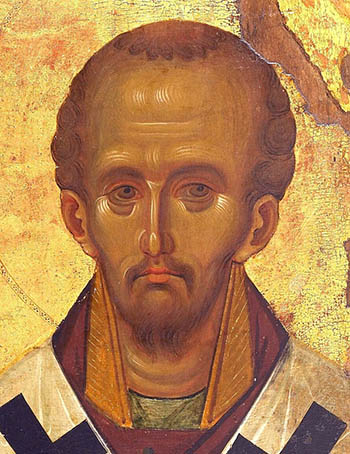
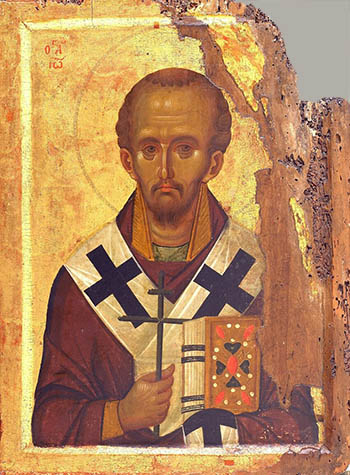
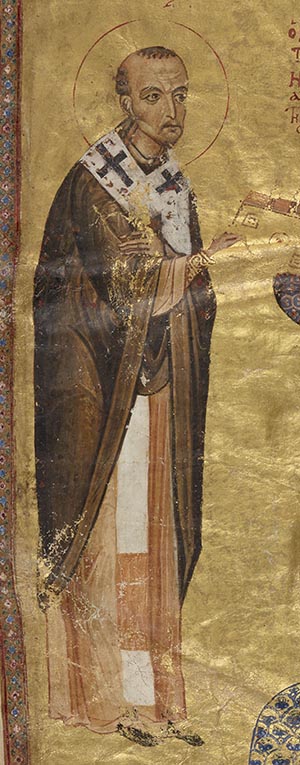

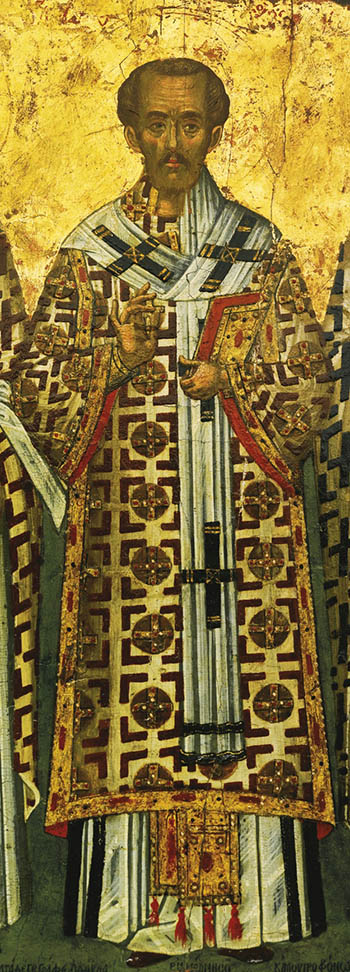
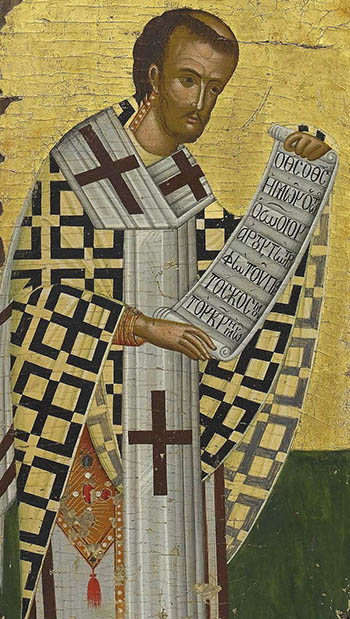
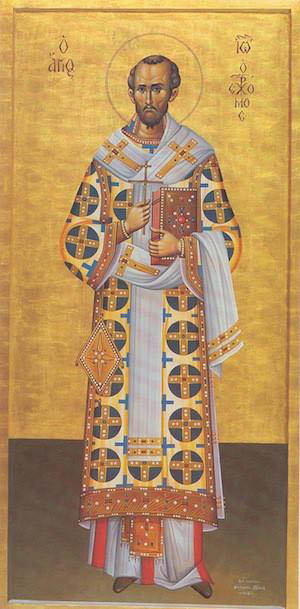








 Background: The entire figure including the nimbus is outlined with two rows of gold cubes, as is also the entire panel inside the decorative frame. The letters of the inscription are outlined with a single row of gold cubes. The background is set flush with the surface. There is a sprinkling of silver cubes in the background, roughly 8 to 10 percent of the total. The average size of the gold tesserae is 6 x 8 mm.
Background: The entire figure including the nimbus is outlined with two rows of gold cubes, as is also the entire panel inside the decorative frame. The letters of the inscription are outlined with a single row of gold cubes. The background is set flush with the surface. There is a sprinkling of silver cubes in the background, roughly 8 to 10 percent of the total. The average size of the gold tesserae is 6 x 8 mm.

 Background: Same characteristics as in the case of St. Ignatius the Younger, except that the proportion of silver cubes is smaller (about 2 percent of the total).
Background: Same characteristics as in the case of St. Ignatius the Younger, except that the proportion of silver cubes is smaller (about 2 percent of the total). Hand: Clumsily drawn, it is outlined all round with dark red glass. The flesh tones are cream and medium pink, highlighted with white marble. The cubes are quite big, up to 12 mm. in length.
Hand: Clumsily drawn, it is outlined all round with dark red glass. The flesh tones are cream and medium pink, highlighted with white marble. The cubes are quite big, up to 12 mm. in length. Background: The surface of the mosaic is rather uneven as also in the case of St. Athanasius. Outlining of figure and letters as in the other panels. The proportion of silver cubes mixed with the gold is about 9 percent and there are also five or six red glass cubes scattered at random. To the right of the figure, below the inscription, is a small cross of which only the top and right arms are preserved. The cross is outlined with a single row of "bottle glass" and is filled with plain gold.
Background: The surface of the mosaic is rather uneven as also in the case of St. Athanasius. Outlining of figure and letters as in the other panels. The proportion of silver cubes mixed with the gold is about 9 percent and there are also five or six red glass cubes scattered at random. To the right of the figure, below the inscription, is a small cross of which only the top and right arms are preserved. The cross is outlined with a single row of "bottle glass" and is filled with plain gold. Head: The hair has an outer and an inner outline in medium purple glass and is drawn in vertical lines, alternately light green glass and white marble. The beard has been treated essentially in the same way: it is outlined and shadowed with light and medium purple as well as olive glass, while the strands of hair are of white marble alternating with light and yellow-green glass. The flesh tones are in white, cream, and one value of pink marble. The face is outlined with one row of light and yellow-green, the same colors being also used for shading, except in the lower part of the cheeks which are shaded in olive. The size of the tesserae used in the head is slightly larger than in the other two panels that have been described, the average being 4 x 6 mm. The pupils of the eyes consist of a single cube of dark purple glass. The whites are of cream marble lit on the spectator's right side with white limestone. Upper lashes dark purple, lower lashes dark olive. Eyebrows light and medium purple. Shadow between eyebrow and upper eyelash light green. The ridge of the nose is formed by one vertical row of white marble. This is followed on the spectator's right by one row of pink marble and one row of olive glass; on the left, by one row of cream marble and one row of light green glass. Nostrils dark purple. The ears are in the same flesh tones as the face and are outlined in red glass. The concha of the right ear is shaded in yellow-green with a couple of red cubes to mark deeper cavities. The lips are of pink marble, the parting being red glass. The shadow at the corners of the mouth is dark purple, whereas under the lower lip it is medium and light purple. A small portion of the neck is visible to the left of the beard from the spectator's point of view. It is in the same flesh tones as the face.
Head: The hair has an outer and an inner outline in medium purple glass and is drawn in vertical lines, alternately light green glass and white marble. The beard has been treated essentially in the same way: it is outlined and shadowed with light and medium purple as well as olive glass, while the strands of hair are of white marble alternating with light and yellow-green glass. The flesh tones are in white, cream, and one value of pink marble. The face is outlined with one row of light and yellow-green, the same colors being also used for shading, except in the lower part of the cheeks which are shaded in olive. The size of the tesserae used in the head is slightly larger than in the other two panels that have been described, the average being 4 x 6 mm. The pupils of the eyes consist of a single cube of dark purple glass. The whites are of cream marble lit on the spectator's right side with white limestone. Upper lashes dark purple, lower lashes dark olive. Eyebrows light and medium purple. Shadow between eyebrow and upper eyelash light green. The ridge of the nose is formed by one vertical row of white marble. This is followed on the spectator's right by one row of pink marble and one row of olive glass; on the left, by one row of cream marble and one row of light green glass. Nostrils dark purple. The ears are in the same flesh tones as the face and are outlined in red glass. The concha of the right ear is shaded in yellow-green with a couple of red cubes to mark deeper cavities. The lips are of pink marble, the parting being red glass. The shadow at the corners of the mouth is dark purple, whereas under the lower lip it is medium and light purple. A small portion of the neck is visible to the left of the beard from the spectator's point of view. It is in the same flesh tones as the face.




 click here for icons of christ
click here for icons of christ click here for icons of the theotokos
click here for icons of the theotokos click here for icons of angels
click here for icons of angels click here for icons of saints
click here for icons of saints








